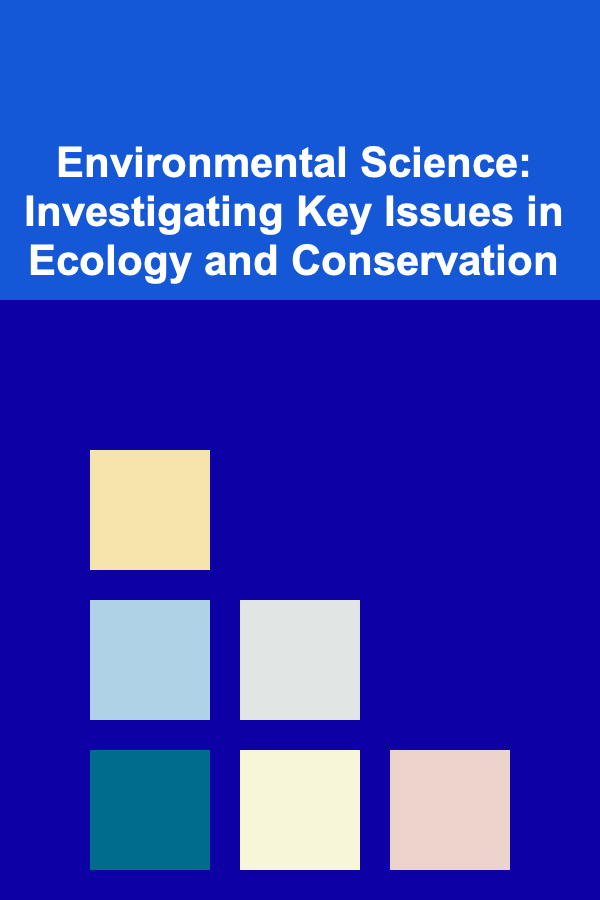
Environmental Science: Investigating Key Issues in Ecology and Conservation
ebook include PDF & Audio bundle (Micro Guide)
$12.99$9.99
Limited Time Offer! Order within the next:

Environmental science is an interdisciplinary field that seeks to understand the complex relationships between humans, ecosystems, and the environment. It integrates various disciplines, including ecology, biology, chemistry, and geology, to address the pressing challenges our planet faces today. In particular, ecology and conservation are two vital areas of environmental science that aim to protect biodiversity and ensure the health of ecosystems that sustain life on Earth. This article explores key issues in ecology and conservation, examining how these issues impact the environment and the importance of addressing them for a sustainable future.
The Decline of Biodiversity
One of the most significant concerns in both ecology and conservation is the rapid loss of biodiversity. Biodiversity refers to the variety and variability of life on Earth, encompassing species, ecosystems, and genetic diversity. The loss of biodiversity is happening at an unprecedented rate, largely due to human activities.
Causes of Biodiversity Loss
The primary drivers of biodiversity loss include:
- Habitat Destruction: Urbanization, deforestation, and agricultural expansion have significantly reduced the natural habitats of many species. Forests, wetlands, grasslands, and coral reefs are disappearing, leaving many species without homes or food sources.
- Climate Change: Climate change has altered ecosystems, shifting temperature and precipitation patterns, which affects species' habitats and migration patterns. For example, coral reefs, which are highly sensitive to temperature changes, are experiencing bleaching events due to rising ocean temperatures.
- Pollution: Pollution in its various forms, including chemical pollutants, plastics, and noise pollution, has a devastating impact on species. Toxic substances can contaminate air, water, and soil, harming both wildlife and plant life.
- Overexploitation: Overfishing, hunting, and poaching have led to significant declines in many species. Unsustainable resource use is depleting populations and threatening the survival of species like elephants, rhinos, and tigers.
- Invasive Species: The introduction of non-native species to new ecosystems often leads to the displacement or extinction of local species. Invasive species can outcompete native species for resources, spread diseases, and disrupt ecosystem dynamics.
The Importance of Biodiversity
Biodiversity plays a critical role in the stability and functioning of ecosystems. Healthy ecosystems provide essential services such as clean water, food, air, and soil, as well as regulating climate and disease. Biodiversity also supports human health by providing a variety of medicinal plants, genetic resources for agriculture, and recreational opportunities. The loss of biodiversity weakens ecosystems, making them less resilient to environmental changes and natural disasters.
Habitat Conservation and Restoration
To address the biodiversity crisis, habitat conservation and restoration are fundamental. Conservation efforts aim to protect existing natural habitats, while restoration seeks to rehabilitate ecosystems that have been damaged or destroyed.
Protected Areas and Reserves
Establishing protected areas such as national parks, wildlife reserves, and marine protected areas (MPAs) is one of the most effective ways to conserve habitats and species. These areas help to safeguard ecosystems from human activities, providing a refuge for wildlife. However, the success of protected areas depends on proper management, monitoring, and enforcement of regulations.
Ecological Restoration
Ecological restoration is the process of restoring degraded or destroyed ecosystems to a state of health and functionality. This can include activities such as reforestation, wetland restoration, and the rehabilitation of coral reefs. Restoration not only benefits wildlife but also enhances ecosystem services, which in turn support human well-being. However, restoration efforts require significant investment in time, resources, and expertise.
The Role of Sustainable Agriculture
Agriculture plays a major role in both habitat destruction and conservation. Shifting to more sustainable agricultural practices can reduce the impact on ecosystems and help conserve biodiversity. Techniques such as agroforestry, crop rotation, and organic farming promote biodiversity by maintaining soil health, reducing pesticide use, and supporting a variety of plant and animal species within agricultural landscapes.
Climate Change and its Ecological Impact
Climate change is perhaps the most pressing environmental issue of our time, and its effects on ecology and conservation are profound. Changes in temperature, weather patterns, and sea levels are directly impacting ecosystems and species across the globe.
Impact on Species
Many species are struggling to adapt to the rapid pace of climate change. Some species may be able to migrate to cooler areas or higher altitudes, but others are unable to do so due to geographic barriers. Climate change is also disrupting the timing of natural events, such as migration and reproduction, leading to mismatches between species and their food sources.
For instance, many migratory birds are arriving at breeding grounds too early or too late, resulting in a mismatch with the availability of food. Similarly, changes in ocean temperatures are affecting the breeding patterns of marine species like fish and sea turtles.
Ecosystem Disruption
Climate change is altering ecosystems, creating new challenges for conservation. For example, in polar regions, melting ice is threatening the survival of species such as polar bears and penguins, which rely on ice for breeding and hunting. In tropical regions, coral reefs are experiencing bleaching events due to warmer ocean temperatures, leading to the destruction of marine biodiversity.
Mitigation and Adaptation Strategies
To address the impact of climate change on ecosystems, mitigation and adaptation strategies are essential. Mitigation focuses on reducing greenhouse gas emissions through renewable energy, energy efficiency, and carbon sequestration. Adaptation strategies, on the other hand, involve helping species and ecosystems adjust to changing conditions. These may include creating wildlife corridors to allow species to migrate or restoring coastal habitats to protect against rising sea levels.
The Role of Conservation Biology
Conservation biology is a subfield of ecology that focuses specifically on the preservation of biodiversity. Conservation biologists work to understand the factors that threaten species and ecosystems and develop strategies to mitigate those threats. This field plays a crucial role in the identification of conservation priorities, the creation of protected areas, and the restoration of habitats.
Endangered Species Protection
One of the core focuses of conservation biology is the protection of endangered species. The International Union for Conservation of Nature (IUCN) maintains the Red List, which categorizes species based on their extinction risk. Conservation efforts include captive breeding programs, habitat restoration, and anti-poaching measures. Protecting endangered species is not only important for maintaining biodiversity but also for preserving the intricate web of life that supports ecological balance.
Ecosystem-Based Management
Ecosystem-based management (EBM) is an approach that aims to manage entire ecosystems rather than focusing on individual species. By considering the interactions between species, habitats, and environmental processes, EBM seeks to maintain the health and resilience of ecosystems. This holistic approach is particularly important for addressing complex environmental challenges such as climate change and habitat loss.
Conservation Policy and Public Awareness
The success of conservation efforts is closely tied to public awareness and political action. Environmental policies and regulations play a critical role in protecting ecosystems and species. For instance, international agreements like the Convention on Biological Diversity (CBD) and the Paris Agreement on climate change provide frameworks for global cooperation on environmental issues.
Policy Solutions
Governments can enact policies that incentivize sustainable practices, such as tax breaks for landowners who protect wildlife habitats or subsidies for farmers who adopt conservation-friendly techniques. Strong enforcement of environmental regulations is also crucial to combat illegal activities like poaching and deforestation.
Public Engagement and Education
Public engagement is essential for garnering support for conservation initiatives. Educating the public about the importance of biodiversity and the threats it faces can lead to greater community involvement in conservation efforts. Grassroots movements, conservation organizations, and environmental education programs can raise awareness and inspire action at the local, national, and global levels.
Conclusion
Environmental science, particularly in the fields of ecology and conservation, is critical to addressing the environmental challenges we face today. The loss of biodiversity, habitat destruction, climate change, and pollution are all major issues that threaten the health of our planet. However, through concerted conservation efforts, habitat restoration, sustainable practices, and public awareness, we can work towards a more sustainable future. The fight to preserve biodiversity and protect ecosystems is not just about saving individual species but ensuring the survival of the entire web of life that sustains us all. By taking action now, we can help safeguard the planet for future generations.

10 Affordable Options for Pet Grooming and Vet Care You Can Trust
Read More
How to Create a Stunning Holiday Entryway to Greet Guests
Read More
How to Financially Plan for a Small Business Venture
Read More
How to Make the Most of Your Outdoor Storage Options
Read More
How to Optimize Lighting for Functionality and Safety
Read More
How to Use Magazine Holders for Efficient Paper Storage
Read MoreOther Products

10 Affordable Options for Pet Grooming and Vet Care You Can Trust
Read More
How to Create a Stunning Holiday Entryway to Greet Guests
Read More
How to Financially Plan for a Small Business Venture
Read More
How to Make the Most of Your Outdoor Storage Options
Read More
How to Optimize Lighting for Functionality and Safety
Read More